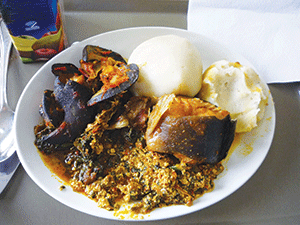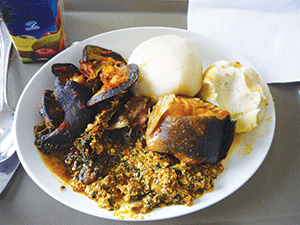There is no soup, save probably pepper soup, that is not eaten with a pudding. These solid meals are referred to as ‘swallow’ (in Nigerian local parlance) because they are simply ‘swallowed’ with the soup. They are mostly starchy solids and, after preparation, thick, elastic and easily malleable with a dough-like consistency. They are generally made from cassava, yam, rice, corn, wheat or plantain.
The swallow
 Getting pounded yam onto the table takes a lot of stress, which is why some people buy packaged yam flour.
Getting pounded yam onto the table takes a lot of stress, which is why some people buy packaged yam flour.
But “if it is not made in a mortar, it is not pounded yam,” stressed Michael Elebiju, an Ondo State indigene.
Pounded yam can only be prepared from yam; cut up and cooked before pounding in a mortar with pestle, but it should not be too soft. The pounding is done until the paste is smooth, firm but elastic with a dough-like consistency.
Amala in its powdery form is known as elubo (in Yoruba where it is mostly eaten), and there are two types; lafu (made from cassava) and isu (made from the brown skin of yam). The difference between these two elubo is in their colour and preparation. Lafu is usually white, but elubo isu is light brown in colour.
Lafu seems to be the easiest to prepare. The water should not boil and heat turned off completely before stirring in the lafu. In contrast, elubo isu must be stirred into boiling water and mixed vigorously to form stiff elastic dough without lumps.
This preparation is similar to wheat meal made from wheat flour or semolina made from milled durum wheat, plantain swallow made from dried unripe plantain and tuwo masara, favourite of the Hausa made from corn meal.
Wheat and plantain meal are mostly popular with diabetics and those on diet.
From cassava comes garri (corrupted version of iga-eri, Igbo language meaning ‘will you eat?’) or eba in Yoruba. There are two types of garri; yellow with palm oil added and white which is fried ordinarily.
Although the length of fermentation of the cassava is believed to be responsible for how ‘sour’ garri is, Boluwatife Adeoti, an agriculturist, explained that it helps to reduce potentially toxic carcinogenic compounds contained in cassava.
Eba preparation needs no much expertise; just add the garri to hot water and turn it to form dough. The stiffness of the dough usually varies, depending on who is eating it.
Getting fufu/akpu/pupuru (depending on language) out of cassava is also cumbersome. Fermented and sieved cassava is sometimes moulded into a ball for consumers to buy and prepare for consumption.
Akpu is boiled till soft and pounded till it’s smooth, firm and elastic with a dough-like consistency, fufu is consistently turned in a pot on fire till it is ready, while pupuru (mostly made into powdered form by some Ondo indigenes for preservation) is prepared like lafu but with a little time on fire.
Despite the strong smell from this swallow, it is still cherished for soups.
Complements
Although these swallows can accompany any soup depending on taste and preference, some people believe that some are best suited for certain types of soup.
“I cannot eat pounded yam with any other soup but vegetable; eba can go with any one, while ‘draw’ soups are better enjoyed with fufu or amala,” explained Elebiju.
Amala is usually served as ‘abula’ among the Yoruba – abula in the sense that it is spread in a plate for ewedu and gbegiri soups to be in the centre.
For some people, fufu is better with ogbono soup.











